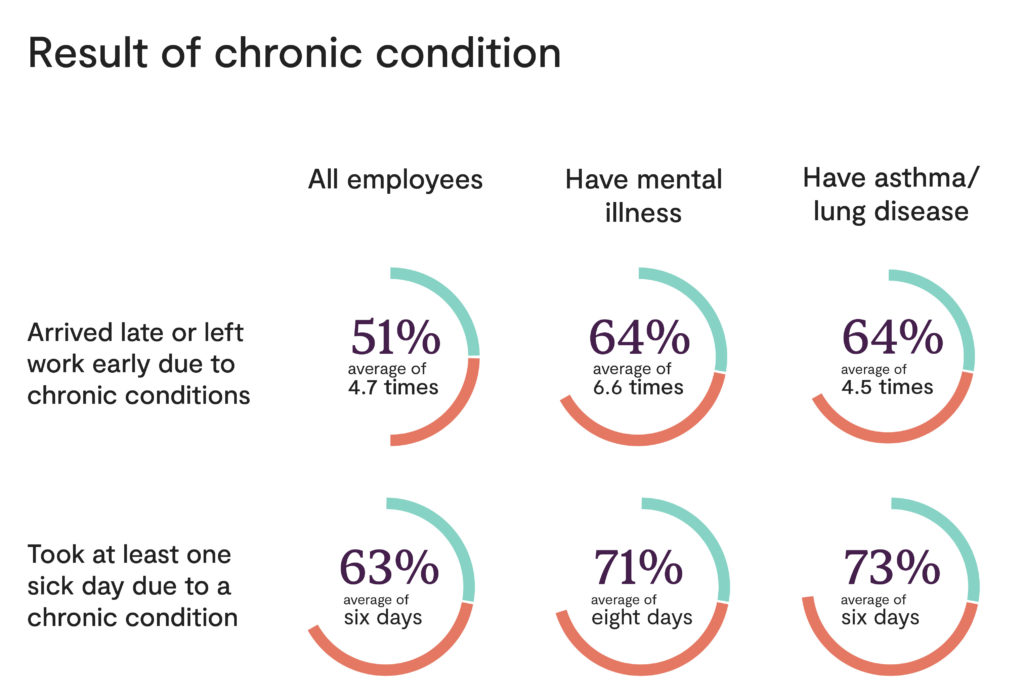See all > Business solutions

How chronic pain impacts the workplace
There are many myths about chronic pain. One is that chronic pain affects only senior citizens, or those with severe but rare genetic conditions. The truth is, chronic pain can impact anyone, from small children, to busy parents, to athletes at the top of their game.
The fact that 70% of surveyed Canadians report suffering from chronic pain goes to show how silent but pervasive this condition is. When it comes to the workplace, chronic pain follows employees throughout their day, making small tasks seem outsized in effort.
What is chronic pain?
Chronic pain results from overactive nerves following an injury or traumatic event. Chronic pain usually lasts longer than six months.
Top chronic pain conditions:
- Arthritis
- Hypertension
- High cholesterol
- Lung disease/asthma
- Mental illness
- Diabetes
What is the impact for employers?
Based on the data, there’s disparity between how employers perceive the long-term health of their staff, and what employees are actually experiencing.
58% — the number of employees who have been diagnosed with at least one chronic condition.
34% — the employer’s average estimate of how many staff members have a chronic condition.
This goes to show that chronic pain is difficult, if not impossible, to identify just by looking at someone. For companies to predict employee productivity, and offer adequate support, then it’s necessary to look at widespread data.
- Six million Canadians, or one in five, have arthritis.
- Three million Canadians have asthma, or 9.5% of the total population.
- One in five Canadians will experience mental illness or addiction in any given year.
Chronic pain and employee absenteeism
Chronic pain is a leading cause for employees taking time off work. Employees with chronic conditions are shown to take more days off, and are more likely to arrive at work late or leave early.

Chronic illness’s financial cost
Employers estimate that 36% of their overall benefit plan costs are attributable to chronic conditions. The real number is likely much higher. For drug plans, 68% of costs go towards medications for chronic conditions and pain.
Then there’s the cost of employee absenteeism, which is not so easily quantifiable. The average employee takes approximately 8.5 sick days per year, costing their employer around $2,000. Employees with chronic pain also find it difficult to be productive while at work. Their symptoms, such as constant discomfort, fatigue, brain fog, and motor issues can get in the way of full performance.
Jamie’s chronic health struggles
Jamie’s had asthma since she was a young child. At the age of six, she found she couldn’t catch her breath during an after-school soccer game. Her parents took her to their family doctor, who diagnosed asthma and provided Jamie with an inhaler for future flare-ups.
Now that Jamie’s in the workforce, she has to balance giving her body rest and care with meeting work deadlines. That’s easier said than done for a young articling attorney. After a huge push of work for a high-profile client, Jamie became mentally and physically exhausted. She developed a cough, which turned into sleepless nights of wheezing, and fatigued mornings that further compromised her immune system.
The vicious cycle led to Jamie developing severe eczema, also known as atopic dermatitis. The eczema spread across her shoulders and down her arms. Despite the hot summer weather, Jamie took to wearing long sleeves to avoid revealing her skin condition to her colleagues. The eczema itched and irritated Jamie, further exacerbating her mental fatigue.
Jamie conceded to take four days off from work to have cool showers, apply calamine lotion, and otherwise wait for her dermatitis to go away. During this time, she became withdrawn from communicating with her friends and co-workers. The mental stress of dealing with asthma, insomnia, and now a visible rash was taking its toll.
How Jamie found relief
Jamie knew she had to seek medical attention, but wasn’t sure where to begin. Should she see a general practitioner for advice, a respirologist for her asthma, or a dermatologist to treat her skin condition? It was a difficult choice, as in the best case scenario a general practitioner visit would require an uncomfortable hour in a clinic waiting room. For specialists like respirologists and dermatologists, Jamie knew it would be around a three month wait to obtain an appointment.
While looking through her employment benefits package to see about booking an acupuncture appointment, Jamie noticed she could see a doctor online within minutes. “Hmm, seems too good to be true,” thought Jamie. “But what do I have to lose?”
To Jamie’s surprise, she received nearly immediate assistance through virtual care. After quickly signing up for a Maple account, she requested to see a general practitioner. Within two minutes, she was matched with a family doctor. The visit began over video chat, where Jamie displayed the full extent of her rash and told her doctor about the asthma flare-up that preceded it. The doctor prescribed both a rash and an airway medication, which Jamie selected to pick up from a nearby pharmacy.
Within hours, Jamie had her medication in hand. The next day, with the help of her prescriptions, Jamie’s breathing felt easy and her eczema no longer itched so strongly. Jamie returned to her office the following Monday with her rash beginning to clear, fully mentally present to take on the next big project.
Action items for employers
Many members of your staff struggle silently with chronic pain. To support their abilities to work productively, and boost the wellness culture of your workplace, consider these steps.
1. Recognize the disparity
Most employers believe there are fairly few employees who deal with chronic pain. The numbers tell a different story. Employers need to be aware of the tendency to underestimate chronic pain within their workforce.
To rectify this, anonymously survey your employees to see if they’re comfortable disclosing their conditions. Let them know that they will in no way be penalized for sharing their information — the findings will only be used to better support them. Also make it clear that they can opt out from sharing this personal medical information.
Look to public health data around chronic pain, such as the national websites for common chronic conditions. Use the reported data, and not an estimate of your office, to improve health programs and initiatives.
- The Arthritis Society
- Canadian Mental Health Association
- Hypertension Canada
- Heart and Stroke Foundation of Canada
- Canadian Lung Association
- Asthma Canada
- Diabetes Canada
2. Embrace technology
People of all ages are increasingly open to using technology to support their health. 53% of employees say they would use a device to support their health and fitness goals, up from 32% in 2015. Employees with chronic pain can use journaling apps to record their progression of symptoms, nutrition trackers to monitor their diet, and virtual care to see a doctor on demand.
Virtual care is one of the most rapidly growing areas in employee benefit plans. There are few tools that offer the same level of personalized, effective support. Employees can speak to a general practitioner to renew a prescription and find relief from symptoms. They can also speak to specialists such as endocrinologists, respirologists, dermatologists, and a variety of mental health practitioners.
3. Provide support for younger employees
Employees in the 18-34 year old age range are shown to be more susceptible to taking days off work to handle chronic conditions. This age range is also reported to experience more workplace mental stress. The upside is, younger employees are more open to using health technology. By cultivating a positive office culture, and providing technology tools, employers can power their younger cohort of employees to work and feel their best.
For more information on virtual care to manage chronic pain, mental health, and to improve workplace wellness, contact [email protected].
Trusted by millions of Canadians
Get started now
Transform your business by partnering with us
Shorten recovery times, lower costs and improve health outcomes with virtual care solutions that are personalized to your business needs.
Learn moreDo you need medical care today?
Trusted, experienced doctors and nurse practitioners are ready to see you.
